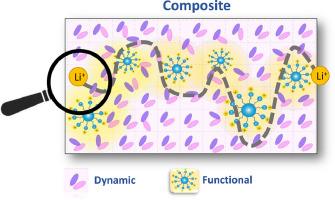Probing disorder and dynamics in composite electrolytes of an organic ionic plastic crystal and lithium functionalised acrylic polymer nanoparticles
Abstract
Solid composite electrolytes combining an ionic molecular phase to facilitate ion transport with a polymeric component to provide mechanical strength are promising material for solid-state batteries. However, the structure-property relationships of these complex composites are not fully understood. Herein we study composites combining the non-flammability and thermal stability of the organic ionic plastic crystal (OIPC) N-methyl-N-ethylpyrrolidinium bis(trifluoromethanesulfonyl) amide [C2mpyr][TFSI] with the mechanical strength of acrylic polymer nanoparticles functionalised with sulphonamide groups having lithium counter-cations. The effect of the formation of interfaces and interfacial regions between the OIPC and polymer nanoparticle on the thermal stability, ion transport, morphology and ion dynamics were studied. It was found that the composites where an interphase was formed by local mixing of the polymer with the OIPC upon heating showed higher local disorder in the OIPC phase and enhanced ion transport in comparison with the as-prepared composites. In addition, doping the composite with LiTFSI salt led to further structural disorder in the OIPC and a selective increase in lithium-ion mobility. Such an improved fundamental understanding of structure, dynamics and interfacial regions in solid electrolyte composites can inform the design of OIPC-polymer nanoparticle composites with enhanced properties for application as solid electrolyte in batteries.


 求助内容:
求助内容: 应助结果提醒方式:
应助结果提醒方式:


